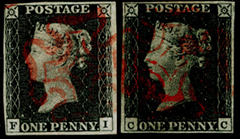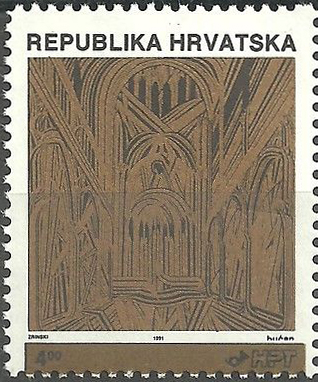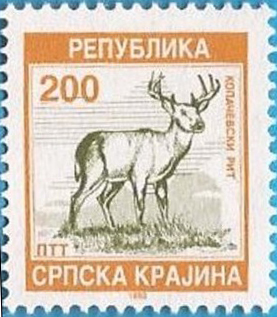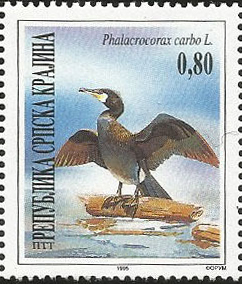 First Issues Collectors Club
of stamps and philatelic material
First Issues Collectors Club
of stamps and philatelic material
Home - Catalog - Categories - Index - Journal - Exhibits - Auctions - Forgeries - Join
 First Issues Collectors Club
of stamps and philatelic material
First Issues Collectors Club
of stamps and philatelic material
Home - Catalog - Categories - Index - Journal - Exhibits - Auctions - Forgeries - Join
| first issues > countries > croatia |
| Europe | 52 a-b |
| Description | Scott# † | SG# | Mi# | Y&T# | ||
|---|---|---|---|---|---|---|
| 50 paras orange | 1 | 1 | ||||
| 1 dinar yellow-green | 2 | 2 | ||||
| 1.50d red | 3 | 3 | ||||
| 2d deep magenta | 4 | 4 | ||||
| 3d dull red brown | 5 | 5 | ||||
| 4d ultra | 6 | 6 | ||||
| 5d dark blue | 7 | 7 | ||||
| 5.50d dark violet brown | 8 | 8 |
† Scott lists a number of inverted and doubled overprint varieties designated "a" for this set. It also warns of commonplace forgeries of all the overprints.
The Indepedent State of Croatia existed from 1941- 45 and then, after WW2, became part of Yugoslavia.
 |
 |
first independent issue |
Independence |
| Sc100 SG159 | Sc101 SG188 |
Independence
Croatia declared itself independent in 1991 and its first issue was a Postal Tax stamp in April of that year (Sc-RA20) for the benefit of the Workers' Fund. this was issued surcharged in November as a postage stamp (Sc100 SG150), followed in December by a stamp celebrating independence (Sc101).
Both catalogues list perf variants for the Postal Tax stamp and the surcharged postage stamp.
 |
 |
Republic of Srpska Krajina |
Sremsko Baranjska Oblast |
| 1993 SG-K1 | 1995 SG-K39 |
Serbian Posts
Gibbons lists two "Serbian Posts In Croatia", not listed in Scott. ‡
Republic of Srpska Krajina
After Croatia's declaration of independence from Yugoslavia in 1991, fighting broke out between the Serb population (backed by units of the Yugoslav Federal Army) and Croatian forces. By the time a ceasefire (sponsored by the UN and the EU) was agreed in January 1992, the Serb faction controlled around a third of the country comprising Krajina, Western Slavonia and Eastern Slavonia. The Yugoslav army withdrew and the area was supervised by the UN. In 1993 the Republic of Srpska Krajina was declared, encompassing the three regions and a parliament and president elected.
Sremsko Baranjska Oblast
In August 1995, the Croatian army occupied most of Krajina and reincorporated it into Croatia. Eastern Slavonia remained separate and protected by the UN and renamed Sremsko Baranjska Oblast (the Srem and Baranya Region. The postal administration of the Region was taken over by the Croation authorities in May 1997 and Eastern Slovonia returned to Croat control in January 1998.
Gibbons numbers Krajina SG-K1 to K38 and Sremsko Baranjska Oblast SG-K39 to K78.
‡ Tim Balm comments, “The short story is that these are not listed in Scott. I suspect because their independence was never recognized by the United Nations, and they were never accepted into the UPU (Universal Postal Union) that controls the money flow between nations for delivery of international mail. Scott requires both of these to occur before being listed. Otherwise, Scott considers them a "local" which they rarely list …
This was printed in Scott Stamp Monthly in May, 2010. "At the beginning of 1990, Yugoslavia had divided into independent states: Macedonia, Bosnia, Croatia, and Slovenia. Only Serbia and Montenegro had remained in some loose union which had the name Yugoslavia. Ethnic Serbian areas did not want to be part of Croatia, and with the support of the former Yugoslav Army (where the officers had been mostly Serbs) announced their sovereignty under the name KRAJINA, more precisely Rep. Srpska-Krajina. More than 100 post offices were open in 1993 and they needed stamps. Thus the Krajina stamp issues began. ... Because of the pressure of the United Nations, Krajina became part of Croatia. The most eastern section of Krajina remained independent under the name of Sremsko-Baranjska Oblast until May 19, 1997. There have been no more stamps since that date."
”